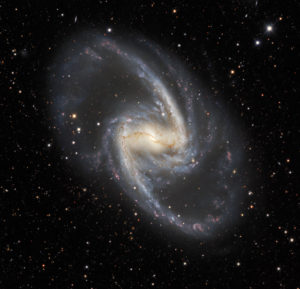
Core and eastern arc of barred-spiral galaxy NGC-1365 imaged with JWST NirCam at 2.0, 3.0 and 3.6 microns. Hi-res download options available below. Myriad A and early F-class stars populate the bar, 99,000 light years from one side to the other. (natural color, 21 mb jpg download, 8250 × 4334)
On July 12th of this year, the world was gifted with 5 studies and a treasure trove of data and images, content released through NASA’s Early Release Observations (ERO) program for JWST (attribution at the foot of this page). The great thing about a public space agency: the fruits and products of the agency are in the public domain.
Why do I mention this?
The 5 studies released by NASA were meant to showcase the power and capability of JWST. This is not to say that other observations with a more scientific and astrophysical nature weren’t completed – they were. And that brings us to this article (and video to follow: link below). Some of these observations were part of the ERO program, some were not. Those observations not part of the ERO are embargoed for 12 months from the date of observation. All data and observations are in the public domain however, some are held in a protected priority status for an observing program’s investigators for 12 months from the date of observation. The embargo allows the investigators to publish their study without undue influence or duress.
Video link included with download options below.
Barred-Spiral Galaxy NGC-1365

The elegant galaxy NGC 1365 in the Fornax Cluster of galaxies imaged from data collected by the Dark Energy Survey (DES) using the Dark Energy Camera attached to the Víctor M. Blanco 4-meter Telescope at Cerro Tololo Inter-American Observatory (CTIO).
This article will discuss the August 13th observation of the Barred-Spiral Galaxy NGC-1365 that was part of the ERO. A barred-spiral galaxy contains a structural “bar” of stars, gas and dust that transects the galactic center, connecting one spiral arm with the other. In the case of NGC-1365, the length of the “bar” is over 99,000 light years from one side to the other. This distance is comparable to the diameter of our home galaxy, the Milky Way. The inner core region of NGC-1365 is 13,332 light years wide or 7.5% the length of the “bar”. If our location in the Milky Way relative to our galactic center were superimposed on the image, it would lie midway along the bar between the core and the star-forming arc.
Member of the Fornax Cluster of Galaxies
Known as “The Great Barred Spiral Galaxy“, NGC-1365 is a Barred-spiral galaxy 55 million light-years distant in the southern constellation Fornax and a member of the Fornax cluster of galaxies. We see the galaxy today as it was 55 million year ago, 10 million years after the dinosaurs went extinct!
Fornax is visible from mid-northern latitudes during the winter, with NGC-1365 rising to about 13 degrees above the southern horizon at maximum elevation. It is visible now in the pre-dawn hours south and west of Orion.
As we’ll discuss below, the galaxy is host to a rapidly-rotating, 2-million solar mass black hole at its core! And these images bear that out!
The image data was obtained by our astronomers directly from the JWST data repository at the Space Telescope Science Institute and processed it using PixInsight and GIMP. We present these images here and in the upcoming video. Various download options are available below with video link.
Video link included with download options below.
Image Processing and the FITS File Format
It is important to remember none of these images show the galaxy in visible light! All images are composites of 3 separate wavebands in the near infrared. Although NirCam can image long-wave visible light (red, 600 nm wavelength and longer), no image data in that waveband was available.
All image composites were compiled according to the RGB format with the final images rendered in standard FITS file format. FITS or Flexible Image Transport System has been the standard in Astronomy since the early 1990s (1993) when digital technology achieved a certain maturity. Since there are no colors “per se” in the Infrared, the images are thus “false color” by definition. In the download options section below, the 3 grayscale images are included for reference.
RGB Format
RGB format processing uses grayscale images obtained from each of the 3 wavebands in red, green and blue light. Grayscale red, green and blue light images are digitally combined to produce an RGB composite. The color is digitally assigned to each of the grayscale images prior. Prior to that, the 3 images are necessarily digitally star-aligned with one of the images serving as a reference.
We adopted a method similar to NASA in the processing of JWST image data. A color is assigned from blue to red with increasing wavelength since blue light has a shorter wavelength than red. In processing JWST images, we follow NASA procedures on how “Color” is assigned. Since the concept of color is completely subjective and has no meaning outside a “Visible Light” context, “colors” are assigned according to wavelength. Shorter wavelengths are assigned “bluer”, shorter wavelength colors; conversely, longer wavelengths are assigned increasingly “red” colors according to their wavelength.
Blue: 2 microns wavelength
Green: 3 microns wavelength
Red: 3.6 microns wavelength.
Grayscale image exposure times
2.0 microns: 2405 seconds (40 minutes)
3.0 microns: 773 seconds (13 minutes)
3.6 microns: 859 seconds (14 min, 20 sec)
To provide context and a sense of scale regarding the term “wavelength“, the wavelength of yellow-green light is ~500 nanometers. A nanometer is one-billionth of a meter or a million times smaller than a millimeter. The wavelength of yellow-green light is thus 500 times larger than one nanometer. One micron is one-millionth of a meter or 2x larger than the wavelength of yellow-green light. The wavelengths used to produce these images are provided above. Since these wavelengths are in the infrared, the “colors“, while logically assigned, have no visual analog. We cannot “see” in the infrared and thus, the “colors” in the images are entirely subjective based on the logical schema adopted above.
The Images
Full detail-expanded views of all images reveal myriad stars of varying brightness and luminosity everywhere, in the core, the bar and in all the star-forming regions (ex. along the eastern arc and near the core).
We include medium and high-resolution images of:
- The galactic core of NGC-1365 (the green spot at the center is intentional to mark the location of the 2-million solar-mass black hole)
- The galactic core of NGC-1365 with the eastward-facing star-forming arc 50 K-ly from the center
- The full image of NGC-1365 with core
- RGB Grayscale images
Star Fields and the Limiting Magnitude of JWST
Let’s consider the myriad field stars, clearly seen in all the images.
The Hubble telescope can detect objects as faint as a magnitude of +31.5. Applying a basic magnitude calculation for JWST, a 7.3x gain in optical surface area compared to HST results in a 2+ magnitude gain for JWST. That doesn’t seem like much but it amounts to our ability to answer fundamental questions that have eluded us thus far for lack of data: visible light sources at high-z redshifts are redshifted into the 2 – 5 micron range and thus beyond detection. We can now directly observe those objects.
So, what of the stars of NGC-1365?
Adopting a +33.5 magnitude limit for JWST (in the infrared), late A or early F-class main-sequence stars would be at the detection limit for JWST at 17 Million Parsecs (M-Pc) – the distance to NGC-1365. It is important to keep in mind that these stars have their peak output in the UV-A (long wave UV), just beyond the visible. The Stefan-Boltzmann power law tells us that the hotter the star, the shorter the peak-wavelength is with greater power in all wave bands. These stars will thus have a greater relative UV magnitude than IR (remember, the smaller the number, the greater the magnitude).
What does this mean when conducting visual or photometric analysis of the images?
Stellar Populations of Observed Stars
The brighter stars in the N-IR images with increasing wavelength (2.0 – 3.6 micron range) will actually be cooler! This is born out upon visual inspection of the grayscale images (available as a download option) – see sample here:

E-NE section from 2.0 micron grayscale image illustrating stellar populations near the core of NGC-1365. Myriad field stars are A and early F-class stars and evolved sub-giant and giants. The brightest stars are high-luminosity (high-mass) O and B-class stars and evolved supergiants (ex. upper right corner star-forming region).
In all the images, the brightest stars are foreground stars in our own Milky Way. Of the myriad field stars (see color image of the core below, the sample above and all other images) any main sequence stars would be A-class (A0 – A9) and very early F-class (F0) stars and evolved sub-giants and early giants. The brightest stars at distance are high-luminosity (high-mass) O and B-class stars (see the “pink” star forming region in the color image below and on the right in the grayscale sample above – they’re the same region) and evolved supergiants. The sun would thus be well below JWST’s detection threshold at this distance by about +2.5 magnitudes. A telescope in the 10-12-meter class would be necessary to detect it at 17 M-Pc (55 M-Ly).
The blackhole and why Infrared is important
Infrared light is known as heat. All physical objects emit heat and the greater the temperature of an object, the greater the luminosity (total radiated output). The peak in the “power spectrum” of such objects, known as “Blackbodies“, shifts towards shorter wavelengths with increasing temperature. Red dwarfs, for example, are cooler and less luminous than the sun and thus the peak in their power spectrum is in the infrared. By comparison, the peak in the sun’s power spectrum is centered at 500 nm wavelength or yellow-green light. This will be important in the discussion that follows.
All these images, as impressive as they are, do not depict visual images but false-color, infrared images.
As we look at the core, we can’t help but notice the brilliance of the swirling gas, the luminous stars and the stunning pink star forming region. New, high-mass stars are embedded in this cloud and are heating it up. In the Infrared, we can see through this leftover gas and dust and observe the embedded stars inside. The outer bands of hot, swirling gas are about 6,500 ly from the core (measured lengthwise, the galactic core is 13,330 ly).
The Rapidly Rotating Blackhole and Active Galactic Nucleus
If we consider the inflowing gas to be a thermal source then, at almost 7,000 light years from the black hole, the spiraling gas has been heated to ~1000 kelvin by differential frictional heating (a 3.6 micron thermal source is ~1000 K). Not much at this distance but, as the gas spirals ever closer, the frictional heating continues to increase, with the gas temperatures reaching into the millions of degrees, spiraling closer and tighter, getting hotter and hotter as the stream of gas approaches the black hole. As it impinges on the black hole’s event horizon, the gravitational gradient is now enormous causing the inflow to become relativistic.
The Core of NGC-1365
The images published here are integrated composites, compiled from 3 grayscale images, each a different wavelength in the infrared. The digital processing software measures the relative intensity of each grayscale image on input. Why do I mention this here? The green spot at the center of the core image is a direct indication of the intensity -at this location. Since green was assigned to the 3-micron waveband, this indicates a non-linear increase in intensity, -at this wavelength! The width of the green spot is 40 pixels; thus, the width of this region is 675 ly (17-ly/ pixel). The intensity, understood to be heat, is increasing at a non-liner rate for the 340-ly region surrounding the black hole. This result is consistent with the proposition described above.
NGC-1365 as an Active Galaxy
At this point, the galactic core has become an x-ray source (million-degree thermal sources emit x-rays) and an Active Galactic Nucleus. An active galaxy is a class of galaxy characterized as hosting a massive black hole at its center and prodigious star formation arising from its effects. NGC-1365 exhibits both and is thus characterized as an Active Galaxy. From the referenced paper’s abstract:
Broad X-ray emission lines from neutral and partially ionized iron observed in active galaxies have been interpreted as fluorescence produced by the reflection of hard X-rays off the inner edge of an accretion disk. [Author’s note: an accretion disk is the spiraling disk of gas surrounding a massive object such as a black hole]
Recent claims that the black hole (2 million solar masses) at the centre of the galaxy NGC 1365 is rotating at close to its maximum possible speed rest on the assumption of relativistic reflection. Here we report X-ray observations of NGC 1365 that reveal the relativistic disk features through broadened Fe line emission and an associated Compton scattering excess of 10-30 keV.
Star forming regions
In the false-color image below, the blue dust bands are cooler and are being drawn in towards the core. The turbulent inflow of gas and dust has triggered a flurry of star formation, clearly manifest in the bright-pink star-forming region in the lower, 3rd quadrant (left, below center) of the image. Active star formation is also observed in the image at the top of the page, along the galaxy’s eastern arc, 50,000 light years from the galactic center!
Stars are forming in the gas and dust in these regions as a result of multiple dynamics in play simultaneously. Much of it is moving at high speeds either by inflow from a massive gravitational source at the center or by compression waves at the edge. Infrared imaging allows us to observe these nascent stars encased in the gas and dust left over from their formation. As the stars mature towards the Main Sequence, their stellar wind disperses the excess gas. Prior to that however, the new stars heat the surrounding gas, thus emitting the infrared light we see.

Core of the barred-spiral galaxy NGC-1365 is presented in this high-contrast image obtained with JWST NirCam at 2.0, 3.0 and 3.6 microns. Green spot at the center identifies the location of the rapidly-rotating black hole. (7 mb download). The false-color blue dust bands are cooler and are being drawn in towards the center. (Extended color, 7 mb download)
Download Options
Note: all images published in this article were produced for Astronomy For Change by James Daly, Ph.D from publicly available image data archived at STSci. These images are free to download for educational and/or non-commercial use.
Image scale: 17 light-years / pixel (all images)
NGC-1365 Core (Extended color, 3703×2671, 7 mb JPEG)
NGC-1365 Core (Extended color, 3703×2671, 20 mb PNG)
NGC-1365 Core (Extended color, 3703×2671, 158 mb TIFF)
NGC-1365 Core (High intensity, 3703×2671, 15 mb JPEG)
NGC-1365 Core (Hight intensity, 3703×2671, 21 mb PNG)
NGC-1365 Core (Natural color 3882×2796, 11 mb JPEG)
NGC-1365 Core (Natural color, 3882×2796, 17 mb PNG, author’s choice, used as the Featured image for this article)
NGC-1365 Core (Saturated color 2588×1822, 6 mb JPEG)
NGC-1365 Core (Saturated color, 2588×1822, 26 mb PNG)
NGC-1365 Full Galaxy with core (Extended color, Full Resolution, 4350×8120, 21 mb JPEG)
NGC-1365 Full Galaxy with core (Extended color, Full Resolutoin, 4350×8120, 48 mb PNG)
NGC-1365 Full Galaxy with core (Extended color, Full Resolution, rotated 90 deg ccw, 8120×4350, 26 mb JPEG)
NGC-1365 Full Galaxy with core (Extended color, Full Resolution, rotated 90 deg ccw, 8120×4350, 76 mb PNG)
NGC-1365 Full Galaxy with core (Extended color, rotated 90 deg ccw, 5073×4328, 13 mb JPEG)
NGC-1365 Full Galaxy with core (Extended color, rotated 90 deg ccw, 5073×4328, 48 mb PNG)
NGC-1365 Full Galaxy with core (Natural color, high-contrast, rotated 90 deg ccw, 8250×4334, 21 mb JPEG)
NGC-1365 Full Galaxy with core (Natural color, high-contrast, rotated 90 deg ccw, 8250×4334, 58 mb PNG)
NGC-1365 Full Galaxy with star-forming arc (Natural color, high-contrast, 4350×8120, 21 mb JPEG)
NGC-1365 Full Galaxy with star-forming arc (Natural color, high-contrast, 4350×8120, 58 mb PNG)
NGC-1365 Core with star-forming arc (Extended color, 4350×8120, 20 mb JPEG)
NGC-1365 Core with star-forming arc (Extended color, 4350×8120, 46 mb PNG)
NGC-1365 2.0 Micron Gray Scale (4568×8387, 18 mb JPEG)
NGC-1365 3.0 Micron Gray Scale (2198×4056, 4.6 mb JPEG)
NGC-1365 3.6 Micron Gray Scale (2198×4056, 4.7 mb JPEG)
Grayscale image exposure times
2.0 microns, 2405 seconds (40 minutes)
3.0 microns, 773 seconds (13 minutes)
3.6 microns, 859 seconds (14 min, 20 sec)
Final post-process FITS files available upon request.
Full-featured video describing how to produce your own high-quality, professional images directly from HST or JWST data:
Attribution
”The Early Release Observations and associated materials were developed, executed, and compiled by the ERO production team: Hannah Braun, Claire Blome, Matthew Brown, Margaret Carruthers, Dan Coe, Joseph DePasquale, Nestor Espinoza, Macarena Garcia Marin, Karl Gordon, Alaina Henry, Leah Hustak, Andi James, Ann Jenkins, Anton Koekemoer, Stephanie LaMassa, David Law, Alexandra Lockwood, Amaya Moro-Martin, Susan Mullally, Alyssa Pagan, Dani Player, Klaus Pontoppidan, Charles Proffitt, Christine Pulliam, Leah Ramsay, Swara Ravindranath, Neill Reid, Massimo Robberto, Elena Sabbi, Leonardo Ubeda. The EROs were also made possible by the foundational efforts and support from the JWST instruments, STScI planning and scheduling, and Data Management teams.”
Astronomy For Change: https://astronomyforchange.org
Did you enjoy this article or like what we do? Why not leave a tip or buy us a Coffee?
Follow Us On Twitter: https://twitter.com/astronomychange
Why not support us on Patreon: https://www.patreon.com/astronomyforchange
Imagination is more important than knowledge
![]()
An index of all articles can be found here.
If you enjoyed this article, please consider supporting us with a modest donation
or through a subscription on our Patreon Page
Membership at Astronomy for Change is Free!




